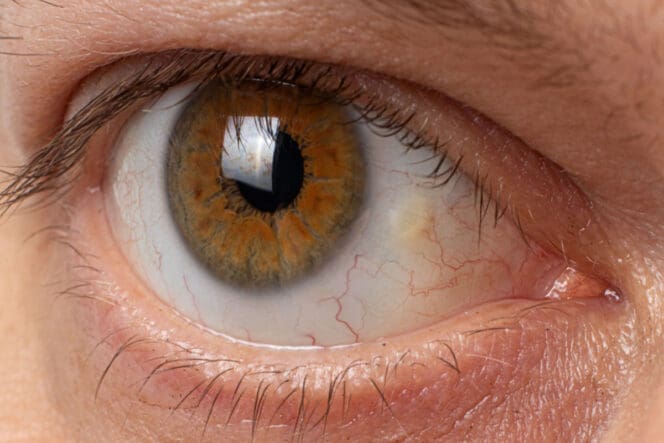Pinguecula (Yellow Bump on Eyeball): Diagnosis, Causes & Treatment
Pinguecula is an eye condition in which yellow bumps develop on the conjunctiva. It doesn’t generally affect vision, but it can cause irritation and redness, which is usually treated with artificial tears.
Pinguecula is a chronic condition, although symptoms are usually fairly manageable.
Symptoms of Pinguecula
Pinguecula is a condition primarily characterized by yellowish growths on the eye’s conjunctiva (the mucous membrane on the front of the eye). It can affect one or both eyes, and multiple growths may present in the same eye at the same time.
These bumps can cause redness and irritation and affect the appearance of the eye.
Over time, pinguecula can eventually develop into pterygium, also called surfer’s eye, where a fleshy growth can develop on the eye. This can often be avoided by making some lifestyle changes when pinguecula is detected.

Pinguecula Causes
The most common cause of pinguecula is chronic exposure to ultraviolet (UV) radiation, usually from the sun. It takes months or years of exposure, generally only presenting in people who work outdoors or spend large amounts of leisure time outdoors, such as at the beach.
Wind and dust are also believed to contribute to the condition.
Risk Factors
By far the most significant contributor to your risk of developing pinguecula is your lifestyle. Spending work and leisure time outdoors or otherwise in a UV-heavy environment, such as in a tanning bed, is more or less the only way to develop pinguecula.
If pinguecula worsens, it can develop into pterygium, also called “surfer’s eye.” This is because these two conditions are associated with surfers, who spend large amounts of time outside on the beach, often with little (if any) eye protection. Beaches have large amounts of particulate matter in the air, and the sun can also easily reflect off the sand and water, further exposing the body to UV rays.
How Pinguecula Is Diagnosed
An ophthalmologist can diagnose this condition as part of a comprehensive eye exam, using a slit lamp microscope to evaluate your eye. It is usually an easy diagnosis to make, as the condition has distinctive and easily observed symptoms.
Pinguecula Treatments
In many cases, pinguecula requires minimum, if any, intervention. If you experience any pain or discomfort, a doctor may prescribe artificial tears or similar lubricants for your eye. Steroids can be used to reduce inflammation.
There is no cure for pinguecula. The only way to remove the bumps is surgery, which doctors are reluctant to recommend unless symptoms are severe. Eye surgery carries serious risks that can impact your eye health.
How to Prevent Yellow Bumps on the Eyeball
The biggest threat to your eyes when it comes to pinguecula is a lack of awareness. Even many people who know the dangers UV rays present to the skin underestimate how they can affect the eyes.
Consistently wearing sunglasses when outdoors can help protect your eyes against UV rays. Even better are goggles with UV-filtering lenses, as goggles can also prevent dust from getting into the eyes.
Taking these precautions makes avoiding pinguecula fairly easy. It also takes significant, long-term UV exposure for pinguecula to develop. While there are other reasons to avoid significant exposure to UV rays, you are unlikely to develop pinguecula from occasional outdoor time, such as going to the beach for a family vacation or hiking several miles a week.
The following tips can help you avoid pinguecula and other UV-light dangers when outdoors:
- Wear sunglasses or UV-blocking glasses outdoors.
- Wear goggles if going into an environment with significant particulate matter in the air, such as deserts or beaches.
- Don’t intentionally expose yourself to artificial UV light, such as from a tanning bed.
Pinguecula FAQs
What causes pinguecula?
While the exact mechanism of pinguecula development is not fully understood, we know it is caused by UV rays, such as those from the sun, combined with exposure to particulate matter like dust blown by the wind.
How do you get rid of yellow bumps on your eye (pinguecula)?
Pinguecula is a chronic condition. The bumps can only be removed surgically, which doctors don’t usually recommend unless they begin to seriously impact your quality of life.
Is pinguecula serious?
No, they are not considered dangerous, as they are benign growths on the eye. Generally, no treatment is recommended unless they are large enough to obscure vision or cause discomfort.
Can screens cause pinguecula?
There is no evidence that screens cause pinguecula. The condition is caused by UV exposure from the sun or tanning beds.
References
-
Pinguecula. American Optometric Association.
-
Pinguecula. (February 2022). StatPearls.
-
Pterygium: An Update on Pathophysiology, Clinical Features, and Management. (May 2021). Therapeutic Advances in Ophthalmology.
-
Correlation Between Prevalence of Pinguecula and Ocular Refraction. (July 2019). Investigative Ophthalmology & Visual Science.
-
What Is a Pinguecula and a Pterygium (Surfer’s Eye)? (November 2021). American Academy of Ophthalmology.
-
Pterygium: Nonsurgical Treatment Using Topical Dipyridamole – A Case Report. (March 2014). Case Reports in Ophthalmology.
-
Transcriptome Analysis of Pterygium and Pinguecula Reveals Evidence of Genomic Instability Associated with Chronic Inflammation. (November 2021). International Journal of Molecular Sciences.
-
The Role of Ultraviolet Radiation in the Pathogenesis of Pterygia (Review). (May 2016). Molecular Medicine Reports.
Last Updated June 14, 2022
Note: This page should not serve as a substitute for professional medical advice from a doctor or specialist. Please review our about page for more information.